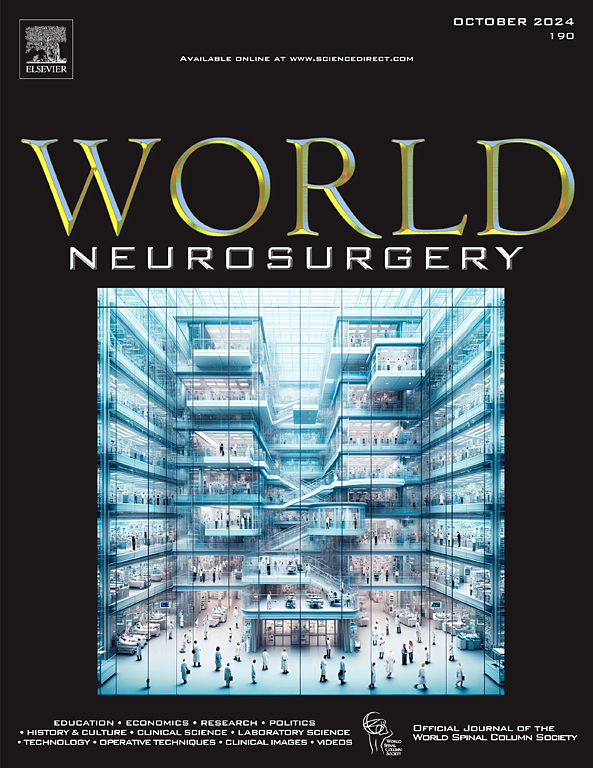矢状正中组织桥作为外伤性颈脊髓损伤神经恢复的预测因子
IF 1.9
4区 医学
Q3 CLINICAL NEUROLOGY
引用次数: 0
摘要
目的探讨亚急性外伤性颈脊髓损伤(SCI)中心髓内损伤和矢状中组织桥与临床长期恢复的关系。方法回顾性分析南昌大学第一附属医院57例外伤性颈椎损伤患者的影像学和临床资料。损伤后1个月的正中矢状面t2加权扫描用于量化病变大小和组织桥宽度。进行相关分析以确定组织桥宽度、病变大小和长期临床恢复之间的关系。结果脊髓损伤后1个月,腹侧矢状中组织桥(VMTB)、背侧矢状中组织桥(DMTB)和总矢状中组织桥(TMTB)与损伤后1年美国脊髓损伤协会损伤评分较高相关。较短的髓内病变长度(IMLL)和较小的髓内病变宽度(IMLW)与较好的预后相关。与VMTB、DMTB、IMLL和IMLW相比,TMTB与美国脊髓损伤协会损伤等级的改善有更强的相关性。预后较差的患者IMLL和IMLW明显高于预后较好的患者,而DMTB、VMTB和TMTB宽度明显低于预后较好的患者。接受者工作特征分析表明,TMTB比其他指标具有更好的预测效果。结论观察到的临床预后与中矢状面组织桥之间的相关性强调了这些结构作为亚急性脊髓损伤患者神经成像生物标志物的临床意义。因此,在临床试验中,中矢状面组织桥可以作为有前途和可靠的磁共振成像生物标志物,用于从急性期到慢性期的分层、治疗和评估患者亚组。本文章由计算机程序翻译,如有差异,请以英文原文为准。
Midsagittal Tissue Bridges as Predictors of Neurological Recovery in Traumatic Cervical Spinal Cord Injury
Objective
This study aimed to explore the relationship between intramedullary injury and midsagittal tissue bridges at the epicenter of subacute traumatic cervical spinal cord injury (SCI) and long-term clinical recovery.
Methods
Imaging and clinical data from 57 traumatic cervical SCI patients at the First Affiliated Hospital of Nanchang University were retrospectively assessed. Midsagittal T2-weighted scans at 1 month postinjury were used to quantify lesion size and tissue bridge width. Correlation analyses were performed to determine the association among tissue bridge width, lesion size, and long-term clinical recovery.
Results
At 1 month after SCI, ventral midsagittal tissue bridges (VMTB), dorsal midsagittal tissue bridges (DMTB), and total midsagittal tissue bridges (TMTB) were associated with better American spinal injury association Impairment Scale grades at 1 year postinjury. Shorter intramedullary lesion length (IMLL) and smaller intramedullary lesion width (IMLW) were linked to better outcomes. TMTB exhibited a stronger correlation with improved American spinal injury association Impairment Scale grades compared to VMTB, DMTB, IMLL, and IMLW. Moreover, IMLL and IMLW were significantly higher, while the DMTB, VMTB, and TMTB widths were significantly lower in patients with a poor prognosis than in those with a good prognosis. Receiver operating characteristic analysis showed TMTB had better predictive performance than other measures.
Conclusions
The observed association between clinical prognosis and midsagittal tissue bridges underscores the clinical relevance of these structures as neuroimaging biomarkers in patients with subacute SCI. Thus, midsagittal tissue bridges may serve as promising and reliable magnetic resonance imaging biomarkers during the transition from acute to chronic phase for stratifying, treating, and evaluating patient subgroups in clinical trials.
求助全文
通过发布文献求助,成功后即可免费获取论文全文。
去求助
来源期刊

World neurosurgery
CLINICAL NEUROLOGY-SURGERY
CiteScore
3.90
自引率
15.00%
发文量
1765
审稿时长
47 days
期刊介绍:
World Neurosurgery has an open access mirror journal World Neurosurgery: X, sharing the same aims and scope, editorial team, submission system and rigorous peer review.
The journal''s mission is to:
-To provide a first-class international forum and a 2-way conduit for dialogue that is relevant to neurosurgeons and providers who care for neurosurgery patients. The categories of the exchanged information include clinical and basic science, as well as global information that provide social, political, educational, economic, cultural or societal insights and knowledge that are of significance and relevance to worldwide neurosurgery patient care.
-To act as a primary intellectual catalyst for the stimulation of creativity, the creation of new knowledge, and the enhancement of quality neurosurgical care worldwide.
-To provide a forum for communication that enriches the lives of all neurosurgeons and their colleagues; and, in so doing, enriches the lives of their patients.
Topics to be addressed in World Neurosurgery include: EDUCATION, ECONOMICS, RESEARCH, POLITICS, HISTORY, CULTURE, CLINICAL SCIENCE, LABORATORY SCIENCE, TECHNOLOGY, OPERATIVE TECHNIQUES, CLINICAL IMAGES, VIDEOS
 求助内容:
求助内容: 应助结果提醒方式:
应助结果提醒方式:


